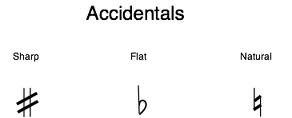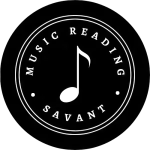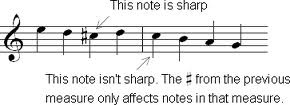Usually, there are not too many problems learning flats, sharps and natural signs. However, the accidentals can sometimes make people a little confused as to what they are supposed to do. It’s not too hard to learn as long as you don’t make it any more complicated than it really needs to be.
The flats and sharps along with the natural signs you find in a piece of music, and not in the key signature, are called accidentals. They are notes that are altered by using either a flat, sharp or natural in the music itself.

In general, an accidental is a note that is different from the key signature. The composer has basically chosen to override the key signature by placing accidentals in front of the individual notes. Again, these could either be flats, sharps or natural signs. By doing this, different musical colors and timbres can be achieved.
For example, the key signature says there is only one flat, Bb. But, there is also an F# written in the music. Is this a mistake? No, the F# is supposed to be there and you would go ahead and play it as written. If you listen to the sound of that note compared to the other notes, you will hear something very unique. This makes the music interesting to listen to with new characteristic sounds.
Can you find more than one accidental in a piece of music? Yes, many times a composer will use accidentals to change the key for a few short measures, but not long enough to merit writing a key change.
There are two important rules to remember when reading accidentals:
1) An accidental sign (flat, sharp or natural) applies to the notes written on the same line or space in that measure only.
2) A bar line cancels all accidentals found in the previous measure with the exception of a note that is tied across the bar line.
When you find an accidental in your music, go ahead and play it just as written. Look for similar notes within the measure that may need to be altered too. Once you are over the bar line, a composer must re-write the accidental again if they want those notes to be altered too.
After spending time playing music for a while, your ear will begin to alert you to a note that should also be altered applying the first rule listed above. If it is not altered properly, you will hear it as a wrong note.
In the meantime, be proactive by scanning your music before playing. Specifically look for accidentals that might apply to other notes in the same measure and write them in.
In no time at all, you will have enough practice with accidentals that finding them and playing them accurately will not be a problem. Just remember to keep it simple and stick to the two rules mentioned above. Good luck and enjoy the new sounds these accidentals create in your music!


I’m trying to learn intervals and am getting tripped up by the accidentals. If there is a g sharp in the key signature, but a g flat accidental, does that g become a natural or a g flat?
Do accidentals (for a particular measure) apply to that note/pitch in both clefs (treble and bass in piano music)?
In piano music, the accidental will appear and be applied by both staves. You will read it in the treble clef and bass clef and play it in both hands.